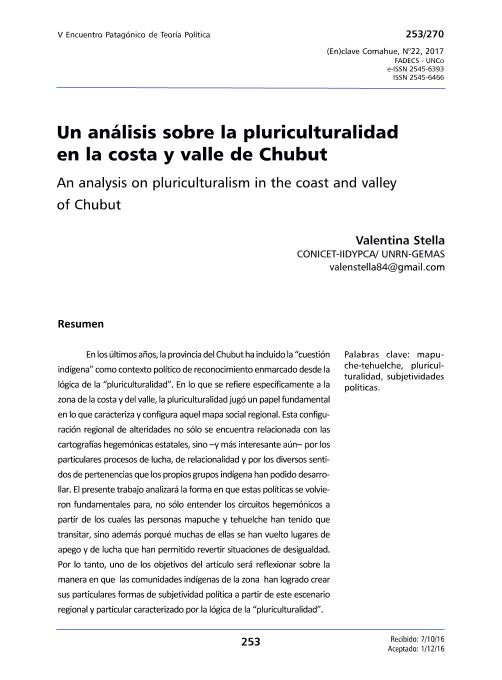Artículo
Enlosúltimos años,laprovinciadelChubutha incluidola “cuestión indígena” como contexto político de reconocimiento enmarcado desde la lógica de la “pluriculturalidad”. En lo que se refiere específicamente a la zona de la costa y del valle, la pluriculturalidad jugó un papelfundamental en lo que caracteriza y configura aquelmapa socialregional. Esta configuración regional de alteridades no sólo se encuentra relacionada con las cartografías hegemónicas estatales,sino –y másinteresante aún– porlos particulares procesos de lucha, de relacionalidad y por los diversos sentidos de pertenencias que los propios gruposindígena han podido desarrollar. El presente trabajo analizará la forma en que estas políticasse volvieron fundamentales para, no sólo entender los circuitos hegemónicos a partir de los cuales las personas mapuche y tehuelche han tenido que transitar, sino además porqué muchas de ellas se han vuelto lugares de apego y de lucha que han permitido revertir situaciones de desigualdad. Por lo tanto, uno de los objetivos del artículo será reflexionar sobre la manera en que las comunidadesindígenas de la zona han logrado crear sus particulares formas de subjetividad política a partir de este escenario regional y particular caracterizado porla lógica de la “pluriculturalidad”. In recent years, the province of Chubut has included the “indigenous question” as a political context for recognition, framed in the logic of “pluriculturalism”. As it relates specifically to the area of the coast and valley, this pluriculturalism played a key role in what characterizes and shapes that regional social map. This regional configuration of otherness not only is related to hegemonic state cartographies, but also –an even more interestingly– to the particular processes of struggle, relationships and senses of belonging that the indigenous groups themselves have been able to develop. This work analyzes how these policies became fundamental not only to understand the hegemonic circuits which the Mapuche and Tehuelche peoples have had to cope with, but also the reasons why many of them have become places of attachment and struggle that allowed reversing situations of inequality. Therefore, one of the objectives of this paper will be to reflect on how indigenous communities in the area have created their particular forms of political subjectivity from this particular regional scenario characterized by the logic of “pluriculturalism”.
Un análisis sobre la pluriculturalidad en la costa y valle de Chubut
Título:
An analysis on pluriculturalism in the coast and valley of Chubut
Fecha de publicación:
04/2017
Editorial:
Universidad Nacional del Comahue. Facultad de Derecho y Ciencias Sociales
Revista:
(En)Clave Comahue
ISSN:
2545-6466
e-ISSN:
2545-6393
Idioma:
Español
Tipo de recurso:
Artículo publicado
Clasificación temática:
Resumen
Archivos asociados
Licencia
Identificadores
Colecciones
Articulos(IIDYPCA)
Articulos de INST. DE INVESTIGACIONES EN DIVERSIDAD CULTURAL Y PROCESOS DE CAMBIO
Articulos de INST. DE INVESTIGACIONES EN DIVERSIDAD CULTURAL Y PROCESOS DE CAMBIO
Citación
Stella, Valentina; Un análisis sobre la pluriculturalidad en la costa y valle de Chubut; Universidad Nacional del Comahue. Facultad de Derecho y Ciencias Sociales; (En)Clave Comahue; 22; 4-2017; 253-269
Compartir




